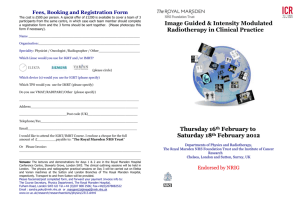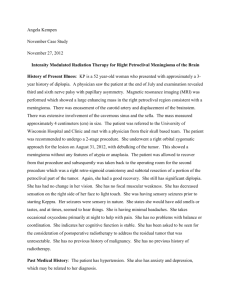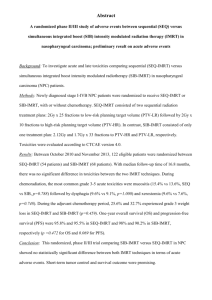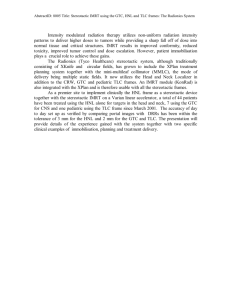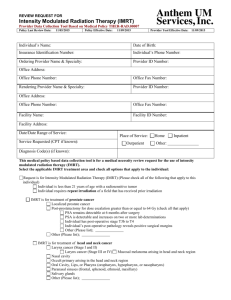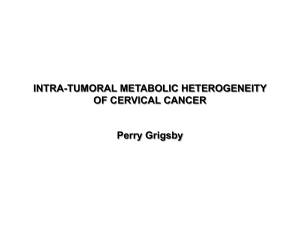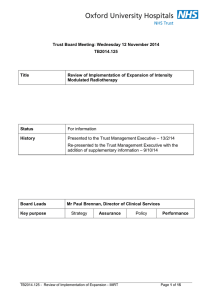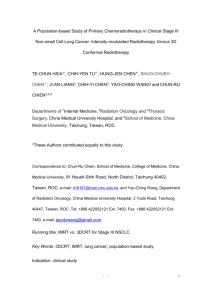teaching slides
advertisement
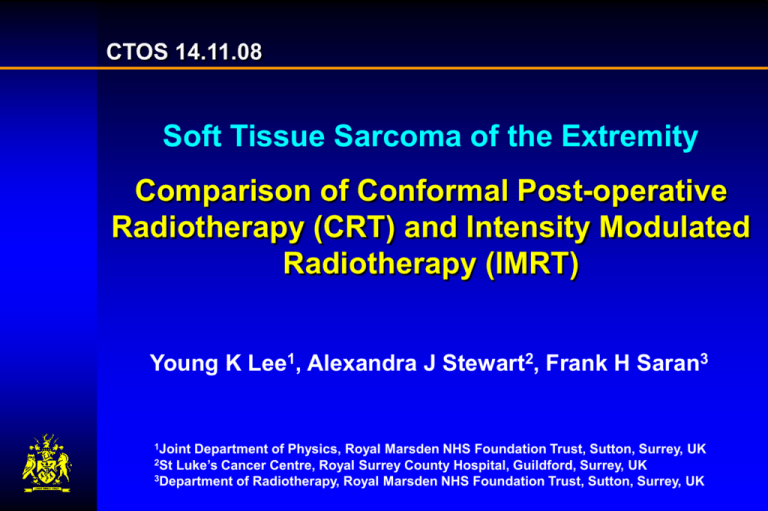
CTOS 14.11.08 Soft Tissue Sarcoma of the Extremity Comparison of Conformal Post-operative Radiotherapy (CRT) and Intensity Modulated Radiotherapy (IMRT) Young K Lee1, Alexandra J Stewart2, Frank H Saran3 1Joint Department of Physics, Royal Marsden NHS Foundation Trust, Sutton, Surrey, UK 2St Luke’s Cancer Centre, Royal Surrey County Hospital, Guildford, Surrey, UK 3Department of Radiotherapy, Royal Marsden NHS Foundation Trust, Sutton, Surrey, UK CRT and IMRT for extremity STS Background Materials and Methods Results Summary CRT and IMRT for extremity STS Background Materials and Methods Results Summary Background Limb-sparing surgery in combination with focal radiotherapy - standard of care in patients with intermediate and high grade limb and limb girdle soft tissue sarcomas (STS) Normal tissue toxicity increases with escalating total and integral dose Dose prescription limited by organs-at-risk (OAR) surrounding the PTV Aims To define a reproducible and comparable target volume definition for CT planning To define reproducible prospective planning dose volume constraints To assess the ability of inversely-planned IMRT plans to minimise the dose to surrounding OAR To assess efficacy of ‘simple’ IMRT compared to ‘complex’ IMRT planning CRT and IMRT for extremity STS Background Materials and Methods Results Summary Patient data T2 and G2/3 STS of the thigh (n=10) No tumours invading bone Entire surgical scar and all drain sites marked Planning CT scan (GE HiSpeed QX/i, Milwaukee, WI) • pelvic brim to below knee • customised immobilisation • slice thickness = 2.5mm Target volume definition Phase I volume PTV1 = tumour bed + 5cm SI and 3cm circumferentially Phase II volume PTV2 = tumour bed + 2cm isotropically OAR defined as whole femur, neurovascular bundle, normal tissue corridor and normal tissue outside PTV1 Planning target volumes PTV1 PTV2 Organ definition neurovascular bundle PTV2 PTV1 whole femur normal tissue outside PTV1 tissue corridor Radiotherapy planning Primary planning objective • PTV dose • femur • skin corridor Other planning objectives • neurovascular bundle • soft tissue outside PTV Dose prescription Pinnacle3 v7.4f (Philips Radiation Oncology Systems, Madison, WI) 2-phase 3D-CRT • Ph I - 50 Gy/25# (5 weeks) • Ph II - 16 Gy/8# (1½ weeks) IMRT with simultaneous integrated boost (SIB) • Ph I - 50 Gy/25# (5 weeks) • Ph II - 62.5 Gy/25# (5 weeks) (/ = 10 Gy) Analysis cumulative dose volume histograms (DVH) Dmean, Dmax, Dmin Conformity Index (CI) Heterogeneity Index (HI) CRT and IMRT for extremity STS Background Materials and Methods Results Summary Conformal 2-34-5 field (simple) Radiotherapy field IMRT IMRT sagittal view conformal 2-3f 4-5f IMRT coronal view conformal 2-3f IMRT 4-5f IMRT Conformity and Heterogeneity 3DCRT Mean Conformity p-value Index (range) 1.76 (1.48-2.47) 2/3f IMRT 1.59 (1.15-2.67) 4/5f IMRT 1.33 (1.08-1.84) Mean Heterogeneity p-value Index (range) 1.052 (1.031-1.065) 0.02 1.045 (1.029-1.063) 0.06 0.0002 1.036 (1.027-1.049) 0.001 DVH summary ‘Simple’ 2-3f IMRT? Median number of segments • 26 (range 13-37) for 2-3f IMRT • 36 (range 34-56) for 4-5f IMRT Both IMRT plans were more conformal and less heterogeneous than 3D-CRT Both IMRT delivered significantly lower femur V45 compared to 3D-CRT plans HOWEVER, 4/5f IMRT resulted in significantly lower femur V45 when compared directly to 2/3f IMRT (p=0.04) CRT and IMRT for extremity STS Background Materials and Methods Results Summary Summary Reproducible, comprehensive planning guidelines and dose-volume constraints for 3D planning for extremity sarcomas devised 4/5f IMRT plan - lowest clinically relevant doses to OAR whilst delivering conformal doses to PTV Large primary tumour • 4/5f preferable to a 2/3f IMRT approach Small, superficial disease • 3D-CRT may provide adequate added cost and complexity treatment without Further work Results from this study may not be directly translated to all other primary locations of STS of the extremity IMRT approach should be assessed prospectively with respect to late toxicity within the confines of a prospective clinical trial Acknowledgment Radiotherapy Department Royal Marsden NHS Foundation Trust
